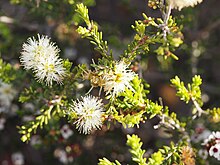Melaleuca bracteosa
| Melaleuca bracteosa | |
|---|---|

| |
| M. bracteosa foliage and flowers. | |
| Scientific classification | |
| Kingdom: | Plantae |
| Clade: | Tracheophytes |
| Clade: | Angiosperms |
| Clade: | Eudicots |
| Clade: | Rosids |
| Order: | Myrtales |
| Family: | Myrtaceae |
| Genus: | Melaleuca |
| Species: | M. bracteosa
|
| Binomial name | |
| Melaleuca bracteosa | |
Melaleuca bracteosa is a low, spreading shrub in the myrtle family, Myrtaceae and is endemic to the south-west of Western Australia. It has tiny, fleshy, non-prickly leaves and cream flowerheads.
Description
Melaleuca bracteosa is sometimes an erect shrub to a height of 1.5 metres (5 ft) but is more usually a low, dense spreading shrub to about 0.5 m (2 ft). Its leaves are narrow oval in shape, 2.7–9 mm (0.1–0.4 in) long and 0.9–1.5 mm (0.04–0.06 in), glabrous, bright green and fleshy with a blunt tip.
The flowers are usually bright cream coloured but sometimes white or mauve-pink. They are in heads, sometimes on the ends of branches and sometimes on the sides of the stem, each head about 16 mm (0.6 in) in diameter and containing 5 to 20 individual flowers. The stamens are arranged in five bundles around the flower, each bundle containing 3 to 8 stamens. The flowering season lasts from August to November and is followed by fruit which are woody capsules 2.4–3.2 mm (0.09–0.1 in) long.[1][2]


Taxonomy and naming
This species was first formally described in 1847 by the Russian botanist Nikolai Turczaninow in Bulletin de la classe physico-mathematique de l'Academie Imperiale des sciences de Saint-Petersburg.[3][4] The specific epithet (bracteosa) is a "reference to the persistent bracts associated with the flowers of this species".[2]
Distribution and habitat
This melaleuca occurs from the Pingrup district south to Albany and east to Ravensthorpe in the Avon Wheatbelt, Esperance Plains, Jarrah Forest and Mallee biogeographic regions.[5] It grows in sand, loam or clay on winter-wet flats or plains[6] often under low trees or tall shrubs.[1]
Conservation
Melaleuca bracteosa is classified as "not threatened" by the Government of Western Australia Department of Parks and Wildlife.[5]
Uses
Essential oils
This species produces sesquiterpene oils at a rate of 0.3% (weight for weight) from fresh leaves.[2]
References
- ^ a b Holliday, Ivan (2004). Melaleucas : a field and garden guide (2nd ed.). Frenchs Forest, N.S.W.: Reed New Holland Publishers. pp. 32–33. ISBN 1876334983.
- ^ a b c Brophy, Joseph J.; Craven, Lyndley A.; Doran, John C. (2013). Melaleucas : their botany, essential oils and uses. Canberra: Australian Centre for International Agricultural Research. p. 96. ISBN 9781922137517.
- ^ "Melaleuca bracteosa". APNI. Retrieved 11 March 2015.
- ^ Turczaninow, Nikolai (1852). Bulletin de la classe physico-mathematique de l'Academie Imperiale des sciences de Saint-Petersburg, Volumes 10-11. St. Petersburg. p. 340. Retrieved 15 March 2015.
{{cite book}}: CS1 maint: location missing publisher (link) - ^ a b "Melaleuca bracteosa". FloraBase. Western Australian Government Department of Biodiversity, Conservation and Attractions.
- ^ Paczkowska, Grazyna; Chapman, Alex R. (2000). The Western Australian flora : a descriptive catalogue. Perth: Wildflower Society of Western Australia. p. 392. ISBN 0646402439.
